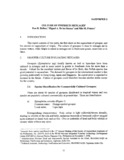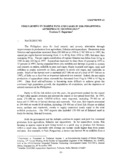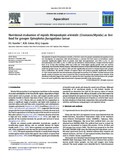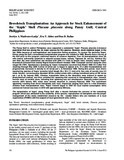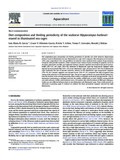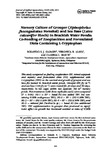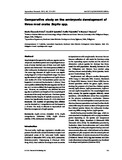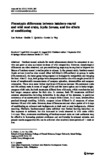Journal Articles: Recent submissions
321-340 / 1234
-
Culture of finfish in netcages
(Society of Aquaculture Engineers of the Philippines, Inc., 1998)This report consists of two parts, the first deals on the cage culture of grouper, and the second on cage culture of tilapia. The culture of groupers is done in netcages set in marine waters, while tilapia is raised in ... -
Fish farming in marine pens and cages in the Philippines: appropriate technology?
(Society of Aquaculture Engineers of the Philippines, Inc., 1998)Contributed as Discussant in Technical Session 3 on Environmental Impacts of Marine Fishcage Farming, 12th Annual Meeting of the Society of Aquaculture Engineers of the Philippines, Inc. (SAEP), held at the BFAR-National ... -
The genus Gracilariopsis (Rhodophyta, Gracilariales) in the Philippines: morphological and taxonomic confirmations
(University of San Carlos, 1998)Reports of the economically-important agarophytic seaweed genus Gracilariopsis Dawson from Philippine waters are verified for the first time. Cystocarpic, spermatangial and tetrasporic materials collected from various ... -
Resistance to antibiotics of Vibrio spp. and Aeromonas spp. isolated from fish and shrimp tissues and rearing water in Panay island, Philippines
(University of the Philippines Visayas, 1998)A survey on the resistance patterns to selected antibiotics of bacterial pathogens of fish and shrimps in Panay Island, Philippines was conducted. One hundred and sixteen (116) bacterial isolates were collected from fish ... -
A parasitological survey of slipper-cupped oysters (Crassostrea iredalei, Faustino, 1932) in the Philippines
(National Shellfisheries Association, 2010)This paper describes the first screening in the Philippines of slipper-cupped oysters (Crassostrea iredalei) for the presence of parasites. Slipper-cupped oysters were sampled at 2 sites in Ivisan, Capiz, from September ... -
The morphology and life cycle of the gill monogenean (Pseudorhabdosynochus lantauensis) on orange-spotted grouper (Epinephelus coioides) cultured in the Philippines
(European Association of Fish Pathologists, 2010)The morphology of Pseudorhabdosynochus lantauensis is described. It is the most numerous parasite recovered from the gills of cultured orange-spotted grouper Epinephelus coioides in the Philippines and is smaller compared ... -
Nutritional evaluation of mysids Mesopodopsis orientalis (Crustacea:Mysida) as live food for grouper Epinephelus fuscoguttatus larvae
(Elsevier, 2010)The potential of mysids Mesopodopsis orientalis as live food source for grouper Epinephelus fuscoguttatus larvae was investigated. In comparison with Artemia biomass, a common live food source in larviculture, mysids ... -
Size measurement and nutritional condition evaluation methods in sandfish (Holothuria scabra Jaeger)
(Wiley, 2012)The aims of this study were to establish an accurate size measurement method and a nutritional condition evaluation method of Holothuria scabra (Jaeger). Although 0.5% KCl and 0.05% MgSO4 did not induce anaesthesia, ... -
Effect of different mangrove-to-pond area ratios on influent water quality and WSSV occurrence in Penaeus monodon semi-intensive farms using the greenwater culture technique
(Elsevier, 2012)White spot syndrome virus (WSSV) has been affecting the shrimp industry worldwide for two decades now. It continues to bring economic losses to affected farms. Despite the many studies on its epidemiology, there is no ... -
Effect of three innovative culture systems on water quality and whitespot syndrome virus (WSSV) viral load in WSSV-fed Penaeus monodon cultured in indoor tanks
(Elsevier, 2012)White spot syndrome virus is the most important among the shrimp diseases. It has been devastating the shrimp industry for more than 3 decades. Previous studies reported that greater percentage of yellow colonies on ... -
Broodstock transplantation: An approach for stock enhancement of the 'kapis' shell Placuna placenta along Panay Gulf, central Philippines
(College of Agriculture, University of the Philippines Los Baños, 2012)The Panay Gulf in central Philippines once supported a substantial ‘kapis’ Placuna placenta (Linnaeus) population that was among the six major sources for this species. However, stock depletion began in the late 1980s ... -
Netcage rearing of the Asian seabass Lates calcarifer (Bloch) in brackishwater pond: The technical and economic efficiency of using high protein diets in fingerling production
(College of Agriculture, University of the Philippines Los Baños, 2012)Intensification in the grow-out culture of high-value fish requires a large quantity of quality fingerlings. Fingerling production is a component of fish farming that comprises nursery and grow-out culture, and may be a ... -
Diet composition and feeding periodicity of the seahorse Hippocampus barbouri reared in illuminated sea cages
(Elsevier, 2012)The zooplankton prey composition and feeding periodicity of juvenile and adult seahorses Hippocampus barbouri reared in illuminated and non-illuminated sea cages were compared. Mean frequency of occurrence (%FO), prey ... -
Nursery culture of grouper (Epinephelus fuscoguttatus Forsskal) and sea bass (Lates calcarifer Bloch) in brackish water ponds: Co-feeding of zooplankton and formulated diets containing L-tryptophan
(Taylor & Francis, 2012)This study compared co-feeding zooplankton (ZP, mixed copepods and mysids) and formulated diets (FD) supplemented with L-tryptophan (TRP) on the survival and growth of grouper and sea bass fry nursed in brackish water ... -
Comparative study on the embryonic development of three mud crabs Scylla spp.
(Blackwell Publishing, 2012)Morphological changes in the embryos, egg size and development, incubation period and morphological structures of newly hatched zoea of three mud crab Scylla species were determined. The three species exhibited similar ... -
White spot syndrome virus (WSSV) risk factors associated with shrimp farming practices in polyculture and monoculture farms in the Philippines
(Elsevier, 2011)White spot sydrome virus (WSSV) is one of the most important viral disease of shrimp. Several studies to control the disease have been done. Tank experiments identified WSSV risk factors related to the physico chemical ... -
Survival and growth of mud crab, Scylla serrata, juveniles subjected to removal or trimming of chelipeds
(Elsevier, 2011)The effects of removing or trimming the chelipeds at various molt stages on regeneration, molt interval (MI) and specific growth rate (SGR) were determined in mud crab Scylla serrata. These strategies in combination with ... -
Domestication of the mud crab Scylla serrata
(Springer Verlag, 2011)The significant decrease in wild mud crab population highlights the need to manage the resources and domesticate crabs. This paper presents the initial results of the domestication of mud crab Scylla serrata aimed at ... -
Phenotypic differences between hatchery-reared and wild mud crabs, Scylla Serrata, and the effects of conditioning
(Springer Verlag, 2011)Hatchery-reared animals for stock enhancement should be competent to survive and grow at rates equivalent to those of wild conspecifics. However, morphological differences are often observed, and pre-conditioning steps may ... -
Susceptibility of hatchery-reared snubnose pompano Trachinotus blochii to natural betanodavirus infection and their immune responses to the inactivated causative virus
(Elsevier, 2011)Mass mortality of snubnose pompano Trachinotus blochii fry exhibiting dark coloration, anorexia, and abnormal swimming behavior was recently documented at the hatchery of the Aquaculture Department of the Southeast Asian ...

